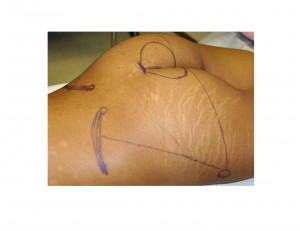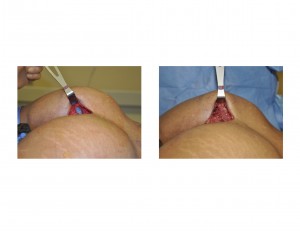Background: Buttock augmentation has surged in popularity over the past decade. Compared to just ten years ago, the number of buttock enhancement procedures in the U.S. has increased a staggering twenty-fold in number. This is due almost exclusively due to the fat injection technique.
Injecting fat into the buttocks for enlargement, also known as the Brazilian Butt Lift (BBL), is a completely natural technique as it uses the patient’s own fat. While no one can predict in any patient how well the fat will survive or the amount of buttock volume increase that will be obtained, the liposuction harvest for the fat is very predictable. From wherever the fat is harvested the patient is assured that they will achieve a reduction in size and contour of the donor site. Most commonly this is going to be an abdominal reduction since this usually offers the greatest donor area. Although as many fat sites as possible is done in many patients to get the fat volume for the buttocks.
But many thin patients have little fat to harvest, making the BBL technique an impossible method. This leaves them with the only choice of the placement of a silicone implant into the buttocks. While having a very assured volume increase outcome, it is a much more invasive buttock augmentation method that has a longer recovery period and a higher risk of complications. With enough motivation, however, patients will embark on this implant method.
In some ways, buttock implants are very similar to breast implants. There is a choice between whether to violate the muscle for implant position or place them on top. While there are arguments for both approaches, the better long-term techique is go inside the muscle. (intramuscular) Because of the course of the sciatic nerve, going under the gluteus maximus muscle is not an option. Rather the muscle belly has to be split and the implant placed between it which is a very technique sensitive procedure.
Case Study: This 22 year-old female desired buttock enlargement and knew full well that she had no fat to give. She was very thin and, no surprisingly, had a flat butt to go with her body habitus.




Case Highlights:
1) For the thin patient that has no significant fat to harvest, implants must be used for buttock augmentation.
2) Buttock implants can be placed either inside the muscle (intramuscular) or above the muscle. (subfascial)
3) Intramuscular buttock implant augmentation offers the best technique for long-term results but has a significant recovery time.
Dr. Barry Eppley
Indianapolis, Indiana


